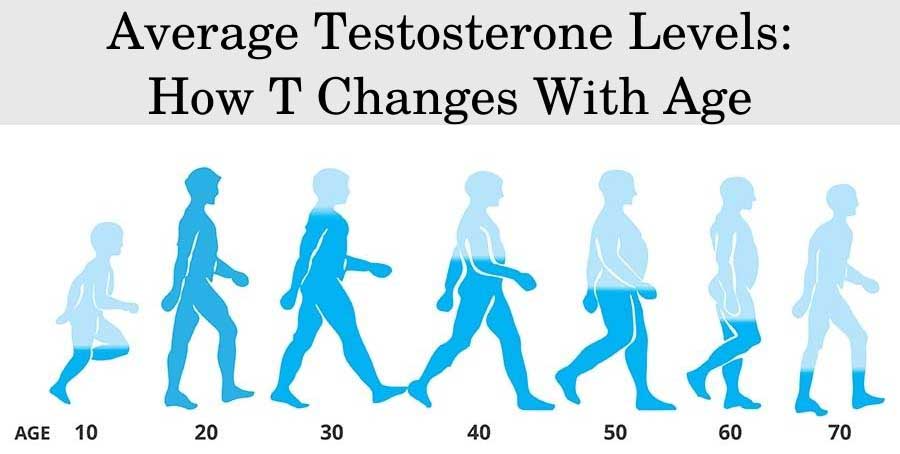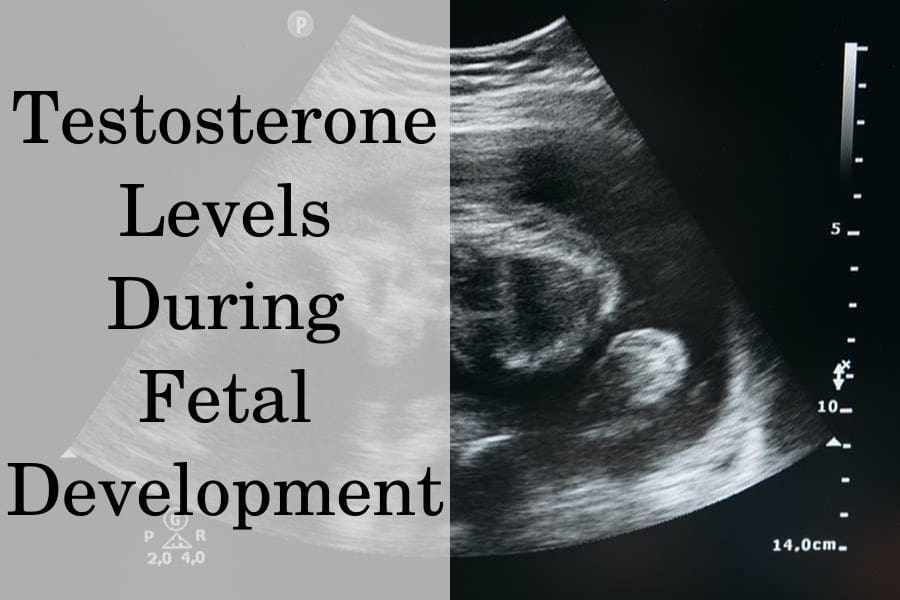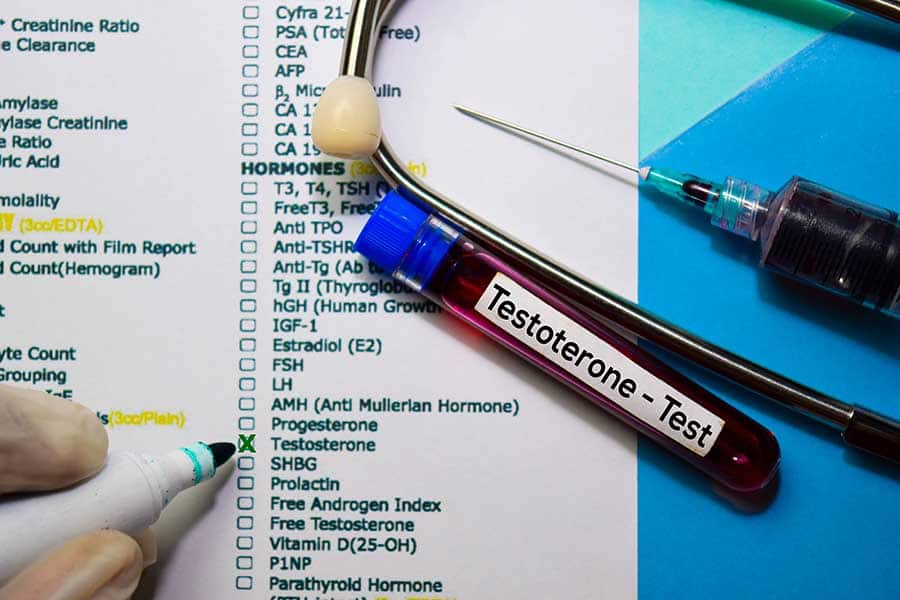Having normal testosterone (T) levels is important at any age. That’s because testosterone plays a crucial role in the normal development of the reproductive organs and regulates sexual function, fertility, mood, body composition, and metabolism.
Depending on your age, a decrease in testosterone levels can lead to delayed puberty, micropenis, sexual dysfunction, weight gain, chronic fatigue, infertility, and other debilitating symptoms.
Usually, these symptoms appear when T levels drop under a certain threshold, which is widely accepted as under 300 ng/dL for adult men and 12 ng/dL for adult women.
The only way to know if your T levels are within the recommended ranges is to get tested.
What are the normal testosterone levels?
Although testosterone is regarded as the male sex hormone, having optimal T levels is important for both men and women. It is essential for your sexual performance, libido, mood, muscle and fat mass, strength, and heart health.
According to the official recommendations, normal testosterone levels in adult men should fall in the range of 300-1000 ng/dL.
Yet, keep in mind that these numbers are still the subject of debate amongst some experts and many regard 250 ng/dL as the lowest physiological value, while others consider levels under 350 ng/dL as a sign of a problem.
One of the causes of these inconsistencies is that testosterone levels may vary depending on age, body composition, lifestyle, etc.
Studies also report differences in testosterone levels by race and ethnicity. In children, Asian Americans had the highest (4.4 ng/dL) mean testosterone levels, while African American children had the lowest (2.8 ng/dL).
On the other hand, Mexican Americans had the highest T levels amongst adults, while Asian Americans had the lowest mean values. Nevertheless, the differences were mostly insignificant, and all mean values ranged from 351-398 ng/dL.
| Ethnicity | Mean T levels in males (ng/dL) | Mean T levels in females (ng/dL) |
| Asian Americans | 337–366 | 16.7–19.9 |
| African Americans | 355–399 | 17.0–19.5 |
| Non–Hispanic Whites | 349–373 | 17.4–19.3 |
| Mexican Americans | 377–419 | 16.8–20.0 |
Normally, females have 20-30 times lower testosterone levels, and the reference range for adult women is 12-60 ng/dL. Women also experience significant hormonal changes during menopause, but their testosterone levels are rarely affected.
Researchers reports either no change or a slight drop in testosterone of about 15% during menopause. Therefore, the range of 12-60 ng/dL also applies to postmenopausal women as a reference for optimal T levels.
In both men and women, T levels tend to peak towards the end of puberty, usually around 15-17 years of age. Following that peak, average testosterone levels start to slowly decline during the 30s in both genders.
Average testosterone levels in males by age
| Age | Total testosterone ranges in males (ng/dL) |
| 6-10 | 2.3–3.2 |
| 11-15 | 96.3–148 |
| 16-19 | 382–446 |
| 20-29 | 382–451 |
| 30-39 | 349–408 |
| 40-49 | 332–372 |
| 50-59 | 340–381 |
| 60-69 | 335–425 |
| 70+ | 267–314 |
Researchers estimate that the decline of T levels in men is about 1.6% per year on average.
Average testosterone levels in females by age
| Age | Total testosterone ranges in females (ng/dL) |
| 6-10 | 3.7–4.6 |
| 11-15 | 18.3–20.8 |
| 16-19 | 22.6–27.2 |
| 20-29 | 24.3–29.9 |
| 30-39 | 20.9–23.1 |
| 40-49 | 17.0–19.5 |
| 50-59 | 15.9–17.6 |
| 60-69 | 13.9–18.0 |
| 70+ | 14.4–17.5 |
Scientists also hypothesize that this decline may be due to the waning of the function of the testicles, but also the waning of the function of the pituitary gland. Normally, the pituitary gland secretes hormones that stimulate T production by the testicles.
A problem in the function of either the testes or the pituitary can lead to the development of male hypogonadism. The condition is defined as total T levels under 300 ng/dL and symptoms of low testosterone.
If your average T levels are lower than 300 ng/dL you should consult with a medical specialist regardless of your symptoms.
Even if you have no symptoms, an endocrinologist can assign you additional tests to determine whether or not your T levels are pathological and evaluate if you may need treatment.
What happens to testosterone levels during fetal development?
Testosterone production begins as early as before birth, during the intrauterine development of the male and female fetus.
In fact, T production is essential for the male fetus, as it controls the differentiation of different tissues and the development of the male reproductive system.
The exact testosterone levels in fetuses’ blood are unknown, as fetal T levels are measured by measuring the corresponding testosterone levels in the amniotic fluid. After the 15th gestational week, average amniotic levels are 25 ng/dL for male fetuses and 8 ng/dL for female fetuses.
The presence of testosterone in female fetuses is mainly due to maternal testosterone and the function of the adrenal glands.
How unhealthy T levels affect fetal development
Lack of testosterone in a male fetus leads to a condition called fetal-onset hypogonadism. The disorder may develop due to dysfunction of the testicles or the pituitary gland.
If it develops due to dysfunction of the testicles, fetal-onset hypogonadism manifests with ambiguous or female genitalia.
If the cause is pituitary dysfunction (secondary hypogonadism), male genitalia will form but remain underdeveloped. That’s because the function of the testes during early fetal development is independent of the pituitary gland so T synthesis will continue until the late fetal period.
On the other hand, studies suggest that exposure to high testosterone levels during fetal development can lead to testicular dysfunction in male fetuses. Female fetuses present with signs of masculinization and ambiguous genitalia.
Research reveals that male fetuses start producing testosterone around the 8th gestational week, and the production peaks around the 12-14th week.
How do T levels change during puberty?
Puberty is the period when testosterone levels peak in both men and women. Usually, the peak occurs towards the end of puberty, which is typically after the age of 15 in both genders.
| Age | Total T values in male (ng/dL) |
| 6-10 | 2.3–3.2 |
| 11-15 | 96.3–148 |
| 16-19 | 382–446 |
Yet, the age at which puberty occurs and how long it lasts can vary a lot between individuals because pubertal development depends on multiple factors, including genetics, race, body composition, etc.
Thus, scientists have established reference ranges for normal testosterone levels depending on the stage of puberty.
| Age | Total T values in female (ng/dL) |
| 6-10 | 3.7–4.6 |
| 11-15 | 18.3–20.8 |
| 16-19 | 22.6–27.2 |
Puberty can be staged according to its visible signs, such as the development of primary and secondary sexual characteristics – pubic hair, axial hair, breast tenderness, and menstruation (in females).
The most widely used system for grading the different stages of puberty is by Tanner. It consists of 5 stages marked with roman numerals. Stage I corresponds to the period before the first signs of puberty occur, while stage V corresponds to the final stage of puberty when all sexual characteristics are fully developed for a young adult.
T levels in different Tanner stages for males:
I: <7 – 20 ng/dL
II: 8 – 66 ng/dL
III: 26 – 800 ng/dL
IV: 85 – 1,200 ng/dL
V: 300 – 1000 ng/dL
T levels in different Tanner stages for females:
I: <7 – 20 ng/dL
II: <7 – 47 ng/dL
III: 17 – 75 ng/dL
IV: 20 – 75 ng/dL
V: 12 – 60 ng/dL
Testosterone affects height and plays a critical role in normal development during puberty. Boys with low T may experience delayed puberty or no puberty at all.
How unhealthy T levels affect pubertal development
Low testosterone in prepubertal boys can impede the growth of muscle mass, genitals, body and facial hair, and masculinization of the voice.
Instead, male children with hypogonadism may develop gynecomastia (enlarged breast tissue), and their limbs may continue growing disproportionately to the torso.
Excessive amounts of testosterone (hyperandrogenism) in boys and girls can lead to early puberty, metabolic problems and infertility.
Hyperandrogenism is much more prevalent in girls compared to boys and the most common cause is polycystic ovary syndrome (PCOS). The condition develops after the onset of puberty when the ovaries start producing both estrogens and testosterone.
The exact cause of PCOS is unknown but scientists report that insulin resistance is one of the main pathogenic factors. It leads to excess insulin which stimulates the overproduction of testosterone by the ovaries and lowers the levels of proteins that inactivate excess T.
>>> Read next: How to balance testosterone in women
PCOS presents with virilization, which involves the development of male sexual characteristics – deeper voice, acne, increased sweating and oily skin, increased body and facial hair growth, and enlarged clitoris.
The development of PCOS during adolescence also has a negative effect on the psychological health of the affected females, and they are more likely to develop anxiety or depression.
What’s the role of testosterone in adulthood?
Both male and female adults need testosterone for normal sexual function and metabolism.
| Age | Total T levels in male (ng/dL) |
| 20-29 | 382–451 |
| 30-39 | 349–408 |
| 40-49 | 332–372 |
| 50-59 | 340–381 |
In men, normal testosterone levels should be in the range of 300 – 1000 ng/dL. Testosterone levels under 300 ng/dL can lead to the development of symptoms typical for male hypogonadism, such as:
- low libido
- erectile dysfunction
- weight gain
- loss of muscle mass and strength
- chronic fatigue and lethargy
- low mood and depression
How unhealthy T levels affect adults
Excessive levels of testosterone in men can lead to gynecomastia, oily skin, acne, high blood pressure, elevated red blood cells, hair loss, excessive body hair, and mood swings. If the cause is steroid abuse, adult males may also experience infertility and testicular atrophy.
High T in women at this age leads to the same problems as in adolescence
Adult women should have testosterone levels in the range of 12 – 60 ng/dL. Average testosterone levels in women can fluctuate according to the menstrual cycle, with the highest levels occurring towards the end of the follicular phase.
| Age | Total T levels in female (ng/dL) |
| 20-29 | 24.3–29.9 |
| 30-39 | 20.9–23.1 |
| 40-49 | 17.0–19.5 |
| 50-59 | 15.9–17.6 |
This phase covers the first 2 weeks of the menstrual cycle and lasts from the beginning of the menstrual bleeding until ovulation.
Women with total T levels under 12 ng/ml may develop symptoms that usually are more subtle than those in men and may include low libido, vaginal dryness, decreased sexual satisfaction, and chronic fatigue.
Changes in T levels at the age of 60-80
Although testosterone levels tend to decline with age, they are no less important for normal sexual function and overall wellbeing. Average testosterone levels in older men are:
| Age | Total T levels in male (ng/dL) |
| 60 | 348–411 |
| 65 | 336–405 |
| 70 | 320–382 |
| 75 | 292–345 |
| 80 | 246–308 |
If testosterone levels in aging males drop under 300 ng/dL, this can lead to the development of late-onset hypogonadism, which manifests with the typical symptoms for low testosterone. Late-onset hypogonadism is also known as andropause or PADAM (Partial Androgen Deficiency in Aging Male).
| Age | Total T levels in female (ng/dL) |
| 60 | 14.9–16.4 |
| 65 | 14.5–16.2 |
| 70 | 14.2–16.3 |
| 75 | 13.9–16.7 |
| 80 | 13.8–17.5 |
Increased levels of testosterone in older age can lead to similar symptoms as those observed in younger adults. It can also worsen several chronic conditions such as high blood pressure, benign prostate hypertrophy, and sleep apnea.
How to check testosterone levels properly
Natural testosterone production in men follows a daily pattern. This means that your natural T synthesis peaks early in the morning and then slowly declines throughout the day.
That’s why your doctor will assign your testosterone tests in the morning. The accuracy of the test is crucial for receiving a proper diagnosis and treatment.
Official guidelines recommend that low T should be diagnosed only after measuring testosterone in serum, and the tests must be in the morning after an overnight fast.
The method used in licensed laboratories for measuring testosterone levels is called isotope dilution mass spectrometry, which is the gold standard for measuring T levels in serum.
If your results suggest that you may have low T, the test should be repeated to confirm the diagnosis.
Furthermore, there is a wide variety of commercial testosterone tests, including at-home test kits which are much more convenient than visiting a laboratory in person.
Unfortunately, the accuracy of at-home tests has not been proven, and there is no guarantee that the samples are not affected by the method of collection and storage. Most at-home tests require a saliva sample rather than a blood sample, which is not accurate enough to make a diagnosis.
Get a free consultation with our medical expert for any questions about hormone replacement therapy



